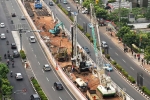Increasing productivity, smallholder oil palm rejuvenation accelerated
This article has been translated by PwC Indonesia as part of our Plantation News Highlights service. PwC Indonesia has not checked the accuracy of, and accepts no responsibility for the content.
Investor Daily - Tingkatkan produktivitas, peremajaan sawit rakyat digas
17 July 2023
By: Tri Listiyarini
Jakarta - To boost national palm oil productivity, the government continues to drive the Smallholder Oil Palm Rejuvenation (PSR) programme that is financed by the Oil Palm Plantation Fund Management Agency (BPDPKS). Smallholder oil palm plantations are the target of the programme as their productivity remains very low. Currently, there are 2.8 million hectares (ha) of oil palm plantations in Indonesia that require rejuvenation as the average age of the plants has surpassed 25 years old.
When he observed the PSR programme and handed over the technical recommendation for the smallholder palm oil mill in Wasegi Indah Village, Prafi District, Manokwari Regency in West Papua Province on Saturday (15/7/2023), Vice President Ma’ruf Amin stated that palm oil significantly contributed to foreign exchange and employment. In 2022, palm oil export contributed Rp468.64 trillion. The commodity also positively contributed to the welfare of 16.2 million workers, of which 4.2 million being direct employees. “There are many benefits from palm oil. Hence, the government continues to give intensive support for the PSR programme nationally,” Vice President Ma’ruf revealed.
The PSR programme is also boosted in Papua, especially in Manokwari and Jayapura, as the oil palm plants there, including the ones planted through the Nucleus Estate and Smallholder (PIR) scheme, are already more than 25 years old. The Steering Committee for the Acceleration of Special Autonomy Development for Papua (BP3OKP) will ensure that the PSR programme in Papua is running smoothly. The Vice President as the coordinator of BP3OKP will discuss PSR in an integrated manner with ministries/institutions, regional governments, and related associations so that PSR becomes the economic model of Papua to be productive, in line with the 2022–2041 Master Plan for the Acceleration of Papua Development. “Farmers in Papua must be ready for PSR. They cannot be left behind by other oil palm regions that are more advanced. However, keep environmental sustainability in mind. Do not damage [the environment],” he stated.
Most oil palm farmers in Manokwari have been planting since 1985, so the plants are no longer productive. In 2021, 2,044 hectares (ha) were rejuvenated through the PSR programme. “The next target is to implement PSR for 350 ha [of oil palm plantations]. Later, all smallholder plantations in Papua will be rejuvenated. We are thankful as the farmers here have consolidated their work through Arfak Sejahtera Producer Cooperative that consists of almost 5,000 households and manages around 9,400 ha [of plantations] that have been fully rejuvenated,” the Vice President said. The Vice President appreciates the PSR programme in Manokwari as they use self-cultivated seedlings. “Once [the plantations] are rejuvenated, they will be productive again. The production will be high. The interesting thing here is that farmers do not buy ready-to-plant seedlings, but they buy sprouts that need to be cared for first. In the future, I hope that they can produce their own sprouts so that they do not need to buy from somewhere else,” the Vice President said.
Distribution of funds
Meanwhile, BPDPKS President Director Eddy Abdurrachman explained that BPDPKS held the authority to manage the palm oil export levy. One of the uses of the palm oil export levy is to finance the PSR programme that is meant to rejuvenate oil palm plants in smallholder plantations that are no longer productive as they have surpassed 25 years of age or came from uncertified/knockoff seeds. PSR is expected to increase the plants’ productivity as they will use certified seeds and the plantations will be managed with good practice. “Until now, BPDPKS has disbursed more than Rp7.78 trillion to fund the PSR programme for 282,409 ha [of plantations] and 124,152 farmers in 21 provinces in Indonesia,” Eddy revealed recently.
Indonesian Palm Oil Association (IPOA) Chairperson Eddy Martono added that increasing productivity would be a challenge for the palm oil industry in the future. In the last four years, palm oil production was stagnant, while domestic consumption continued to rise. “We are concerned as, since 2018, palm oil production has been stagnant and has a tendency to decline, while consumption has been increasing. Export also tends to decline. Hence, we must be able to increase productivity. Everyone must be involved as business players cannot bear the burden alone. The policies must be synchronised and cannot be overlapping. So, there are concerns about the decline [in production]. Do not let what happened to rubber happen to palm oil,” he explained.
Based on the data from the Agriculture Ministry’s Directorate General of Plantation, the national oil palm plantation area reaches 16.38 million ha with 6.94 million ha being smallholder plantations. Out of the 6.94 million ha, 2.8 million ha have the potential to participate in the PSR programme with 2.29 million ha being plasma and independent plantations, 0.14 million ha being plasma PIR-BUN plantations, and 0.37 ha being plasma PIR-TRANS/PIR-KKPA plantations. The PSR target is an average of 180 thousand ha per year, but the realisation is 49 thousand ha per year. Several sources mentioned that the average production of smallholder oil palm plantations only reached 3 tonnes of crude palm oil (CPO) per ha per year, while corporate plantations can produce 6 tonnes per ha per year.
Palm oil mill
As observed by Investor Daily on the social media channel of the Indonesian Vice President on Sunday (16/7/2023), Vice President Ma’ruf is also supporting the acceleration of the palm oil mill construction in Papua so that the production of fresh fruit bunches (FFB) from local farmers can be processed independently. “I instructed for its acceleration, do not delay it again,” the Vice President affirmed. Until now, oil palm farmers in Papua have been selling their FFB to Makassar to be processed at the local palm oil mill. The funds required to construct the palm oil mill of Arfak Sejahtera Producer Cooperative reach Rp80 billion. Some of the funds are provided by BPDPKS, the rest will be borrowed by the cooperative from a state-owned bank through a micro loan.
Indonesian Oil Palm Farmers Association (Apkasindo) Central Executive Board Chairperson Gulat M.E Manurung said that the processing capacity of the palm oil mill that will be constructed would be 15 tonnes of FFB per hour, which can increase to 30 tonnes of FFB per hour. The capacity is set at 15 tonne per hour considering the capability of the productive oil palm plantations that supply the FFB as the raw material. “Once all plantations of Arfak Sejahtera Producer Cooperative have been rejuvenated and all of the plants are productive, the mill’s capacity can reach 30 tonnes per hour,” Gulat stated. Gulat, who was present in Monokwari, said that PSR in West Papua was the best and the palm oil mill that will be constructed would be the first in Indonesia. In the future, West Papua will also be independent regarding cooking oil as a cooking oil mill will be constructed at the same location.














